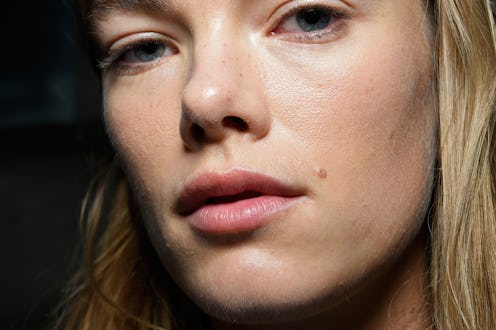(Beauty)
These Breakout Triggers Are So Unexpected (& Surprisingly Common)

When I was diagnosed with dermatitis — a medical catch-all phrase that basically means “irritated skin” — a few years ago, my dermatologists had no idea what caused the dry, itchy patches around my eyes and mouth. My skincare routine hadn’t changed, and neither had my makeup collection… so I was sent home with a topical steroid cream and told to wait it out. The rash persisted, though, and I knew I had to investigate further. I read books on skincare, Googled to no end, and spent a nerdy amount of time on online message boards hoping to stumble across a cure (or at least a cause), and ended up unearthing a host of surprising acne causes that no one ever talks about.
“Many of the products we use each day can cause or exacerbate skin irritation and acne, even if they are not used directly on the face,” Cathy Dye, an aesthetician at Oasis Skin Center in New Mexico, tells The Zoe Report. “It is important to check all of the products you use for irritating or pore-clogging ingredients.” According to Dye, these include obvious culprits like skincare and makeup, and not-so-obvious offenders like lotion, hand sanitizer, toothpaste, fragrance, laundry detergent, and dryer sheets.
Most potential triggers can be categorized in two ways: irritants and allergens. “Irritants are chemicals that are either too abrasive or have low or high pH levels that damage the skin,” Dr. Jennifer Herrmann, a dermatologist at MFC Dermatology and consultant for DNAEGF Renewal, tells The Zoe Report. “Hair dyes, detergents, cleaning chemicals, and some gardening products are often offenders.” Ingredients to watch out for are sodium lauryl sulfate (often referred to as SLS), a foaming agent found in detergent, cleansers, and toothpaste; and alcohol, since a high alcohol content can dry out the skin and leave it susceptible to damage.
Allergens, on the other hand, are “chemicals that incite an immune reaction causing redness, itching, an, in extreme cases, blistering,” she says. “The most common culprits are preservatives and fragrances.” Dr. Herrmann explains that preservatives can be found in cosmetics and skincare, since these substances extend the shelf life of a product. The ones that tend to cause skin reactions include “parabens, formaldehydes, imidazolidinyl urea, quaternium-15, DMDM hydantoin, phenoxyethanol, and methylchloroisothiazolinone."
“As far as fragrances, avoid products with the term parfum on labels, balsum of peru, citronellol, limonene, or linalool,” Dr. Herrmann adds. “Importantly, a product that reads ‘unscented’ may still contain fragrance — products often have ‘masking’ fragrances to cover up other unpleasant chemical odors.”
But it’s not just long-winded, chemical-filled labels to look out for. In the case of irritants and allergens, natural isn’t always better. “Many plant products can be both irritants or allergens — think poison ivy,” Dr. Herrmann tells us. Even the cinnamon extract used to flavor certain toothpastes can causes breakouts and dermatitis around the mouth and chin — and some experts claim that fluoride may have this affect, as well. (In this case of my dermatitis, removing fluoride from my routine helped immensely.)
Ahead of holiday season, watch out for nickel in those sparkly metallic eyeshadows. “Metals, especially nickel, can be potential allergens,” Dr. Herrmann says. “And since eyelid skin is thin and more reactive, this can lead to swollen eyelids.”
Those with sensitive or acne-prone skin need to be extra careful — there are plenty of standard skincare and makeup ingredients that are actually proven pore-cloggers. “Lanolin, which is common in cosmetics and provides softness and moisturization, unfortunately blocks pores,” Dr. Herrmann tells us. “And octyl stearate can make skin soft and smooth, but it’s an oily substance that can lead to breakouts.” The same can be said for silicones. Talc and bismuth oxychloride, two ingredients often found in mineral makeup, can sometimes lead to breakouts; even cocoa butter and coconut oil aren’t off the hook — these beloved ingredients are comedogenic, too.
To treat breakouts, redness, or swelling caused by an irritant or allergen, the first step is to check the ingredient lists of everything you use, from shampoo to perfume. “Get rid of any offending products that include the aforementioned substances,” Dye says. “Once you start using products without irritating or pore-clogging ingredients, the situation should resolve naturally over time.” Dr. Herrmann adds that a mild hydrocortisone cream can help relieve itching and redness in the moment, but if the reaction persists, a trip to the dermatologist for a prescription medication may be in order.
In general, “It’s best to choose products with fewer ingredients as these contain fewer potential triggers,” she says, along with avoiding fragrances and artificial colors whenever possible.
Ready to clean up your entire routine? Dye suggests All Free & Clear as an irritant-free detergent, Tom’s of Maine Toothpaste for fresh breath without the acne flare ups, Priia mineral makeup to keep pores clear, and a sulfate-free shampoo and conditioner, like the ones from SEEN, a dermatologist-formulated hair care line proven to keep pores happy. Overhauling your entire lifestyle to avoid a little skin irritation may seem extreme — but trust me, it’s worth it.